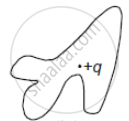Advertisements
Advertisements
प्रश्न
What is the electric flux through a cube of side 1 cm which encloses an electric dipole?
उत्तर
As per the Gauss's law of electrostatics, electric flux through a closed surface is given by
`phi_E=ointvecE.vec(ds)=Q/epsilon_0 `
where
E = Electrostatic field
Q = Total charge enclosed by the surface
∮E=∮E→.ds→=0ε0=0" role="presentation" style="position: relative;">∮E=∮E→.ds→=0ε0=0
∈0 = Absolute electric permittivity of free space
In the given case, cube encloses an electric dipole. Therefore, the total charge enclosed by the cube is zero, i.e. Q = 0.
Therefore, from (i), we have
`phi_E=ointvecE.vec(ds)=0/epsilon_0=0`
APPEARS IN
संबंधित प्रश्न
Define electric flux.
Define Electric Flux. Write its SI unit.
It is said that any charge given to a conductor comes to its surface. Should all the protons come to the surface? Should all the electrons come to the surface? Should all the free electrons come to the surface?
If the flux of the electric field through a closed surface is zero,
(a) the electric field must be zero everywhere on the surface
(b) the electric field may be zero everywhere on the surface
(c) the charge inside the surface must be zero
(d) the charge in the vicinity of the surface must be zero
The following figure shows a closed surface that intersects a conducting sphere. If a positive charge is placed at point P, the flux of the electric field through the closed surface

The electric flux through the surface ______.
 |
 |
 |
 |
| (i) | (ii) | (iii) | (iv) |
A charged particle q is placed at the centre O of cube of length L (A B C D E F G H). Another same charge q is placed at a distance L from O. Then the electric flux through ABCD is ______.
The S.I. unit of electric flux is ______
The electric charges are distributed in a small volume. The flux of the electric field through a spherical surface of radius 10 cm surrounding the total charge is 20 V-m. The flux over a concentric sphere of radius 20 cm will be ______.
A hollow sphere of radius R has a point charge q at its centre. Electric flux emanating from the sphere is X. How will the electric flux change, if at all, when charge q is replaced by an electric dipole?
